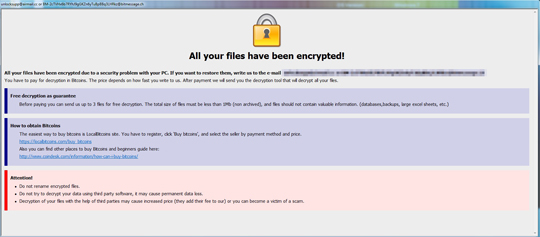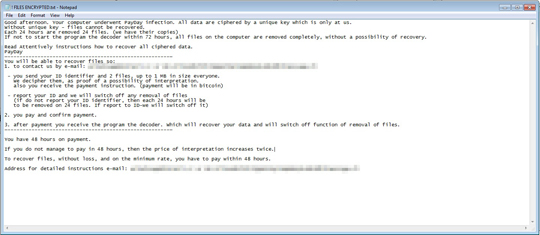RANSOM_BITCOVAR.A
Trojan-Ransom.Win32.Bitcovar.gj (Kaspersky), Ransom:Win32/Betisrypt.D (Microsoft), Gen:Variant.Razy.224118 (Bitdefender)
Windows


Threat Type: Ransomware
Destructiveness: No
Encrypted:
In the wild: Yes
OVERVIEW
Dropped by other malware
This Ransomware arrives on a system as a file dropped by other malware or as a file downloaded unknowingly by users when visiting malicious sites.
It drops files as ransom note.
TECHNICAL DETAILS
358,400 bytes
EXE
Yes
05 Dec 2017
Drops files, Encrypts files
Arrival Details
This Ransomware arrives on a system as a file dropped by other malware or as a file downloaded unknowingly by users when visiting malicious sites.
Installation
This Ransomware adds the following mutexes to ensure that only one of its copies runs at any one time:
- PAYDAYPAYDAY
Autostart Technique
This Ransomware adds the following registry entries to enable its automatic execution at every system startup:
HKEY_CURRENT_USER\Software\Microsoft\
Windows\CurrentVersion\Run
1payday = %Application Data%\payday.hta
HKEY_CURRENT_USER\Software\Microsoft\
Windows\CurrentVersion\Run
2baby = %Application Data%\payday.hta
HKEY_LOCAL_MACHINE\SOFTWARE\Microsoft\
Windows\CurrentVersion\Run
3payday = %Application Data%\payday.hta
HKEY_LOCAL_MACHINE\SOFTWARE\Microsoft\
Windows\CurrentVersion\Run
4baby = %Application Data%\payday.hta
It drops the following files:
- %Application Data%\paydata.hta
- {Drive}\! FILES ENCRYPTED.txt
(Note: %Application Data% is the Application Data folder, where it usually is C:\Documents and Settings\{user name}\Application Data on Windows 2000, Windows Server 2003, and Windows XP (32- and 64-bit); C:\Users\{user name}\AppData\Roaming on Windows Vista (32- and 64-bit), Windows 7 (32- and 64-bit), Windows 8 (32- and 64-bit), Windows 8.1 (32- and 64-bit), Windows Server 2008, and Windows Server 2012.)
Other Details
This Ransomware encrypts files with the following extensions:
- .pps
- .pot
- .xlt
- .pps
- .xlw
- .dot
- .rtf
- .ppt
- .pptx
- .xls
- .xlsx
- .xlw
- .doc
- .docx
- .xml
- .hta
- .htm
- .html
- .jpg
- .jpeg
- .gif
- .png
- .tif
- .tiff
- .bmp
- .ico
- .wmf
- .dib
- .jfif
- .jpe
- .fpx
- .mix
- .dot
- .xbap
- .exe
- .search-ms
- .mht
- .zip
- .dvr-ms
- .wvx
- .wmx
- .wmv
- .wm
- .mpv2
- .mpg
- .mpeg
- .mpe
- .mpa
- .mp2v
- .mp2
- .m1v
- .IVF
- .asx
- .asf
- .wax
- .snd
- .rmi
- .m3u
- .au
- .aiff
- .aifc
- .aif
- .midi
- .mid
- .wma
- .wav
- .mp3
- .wmf
- .tiff
- .tif
- .rle
- .png
- .jpeg
- .jpe
- .jpg
- .jfif
- .ico
- .gif
- .emf
- .dib
- .bmp
It displays a pop-up window with the following message:

It does the following:
- It encrypts all files in fixed and network drives.
- It deletes shadow copies by executing the following command:
- /C vssadmin Delete Shadows /All /Quiet
- /C wmic shadowcopy delete
- /C Bcdedit.exe /set {default} recoveryenabled no
- /C Bcdedit.exe /set {default} bootstatuspolicy ignoreallfailures
Ransomware Routine
This Ransomware appends the following extension to the file name of the encrypted files:
- .[{BLOCKED}supp@{BLOCKED}l.cc or {BLOCKED}VHx6b7RYhJ9gGKZn6yTuBpBBq3LHRkz@{BLOCKED}sage.ch ]-id-260.wallet
It drops the following file(s) as ransom note:
SOLUTION
9.850
13.824.06
04 Dec 2017
13.825.00
05 Dec 2017
Step 1
Before doing any scans, Windows XP, Windows Vista, and Windows 7 users must disable System Restore to allow full scanning of their computers.
Step 2
Note that not all files, folders, and registry keys and entries are installed on your computer during this malware's/spyware's/grayware's execution. This may be due to incomplete installation or other operating system conditions. If you do not find the same files/folders/registry information, please proceed to the next step.
Step 3
Restart in Safe Mode
Step 4
Delete this registry value
Important: Editing the Windows Registry incorrectly can lead to irreversible system malfunction. Please do this step only if you know how or you can ask assistance from your system administrator. Else, check this Microsoft article first before modifying your computer's registry.
- In HKEY_CURRENT_USER\Software\Microsoft\Windows\CurrentVersion\Run
- 1payday = %Application Data%\payday.hta
- 1payday = %Application Data%\payday.hta
- In HKEY_CURRENT_USER\Software\Microsoft\Windows\CurrentVersion\Run
- 2baby = %Application Data%\payday.hta
- 2baby = %Application Data%\payday.hta
- In HKEY_LOCAL_MACHINE\SOFTWARE\Microsoft\Windows\CurrentVersion\Run
- 3payday = %Application Data%\payday.hta
- 3payday = %Application Data%\payday.hta
- In HKEY_LOCAL_MACHINE\SOFTWARE\Microsoft\Windows\CurrentVersion\Run
- 4baby = %Application Data%\payday.hta
- 4baby = %Application Data%\payday.hta
Step 5
Search and delete this file
- %Application Data%\paydata.hta
- {Drive}\! FILES ENCRYPTED.txt
Step 6
Restart in normal mode and scan your computer with your Trend Micro product for files detected as RANSOM_BITCOVAR.A. If the detected files have already been cleaned, deleted, or quarantined by your Trend Micro product, no further step is required. You may opt to simply delete the quarantined files. Please check this Knowledge Base page for more information.
Step 7
Restore encrypted files from backup.
Step 8
Scan your computer with your Trend Micro product to delete files detected as RANSOM_BITCOVAR.A. If the detected files have already been cleaned, deleted, or quarantined by your Trend Micro product, no further step is required. You may opt to simply delete the quarantined files. Please check the following Trend Micro Support pages for more information:
Did this description help? Tell us how we did.


